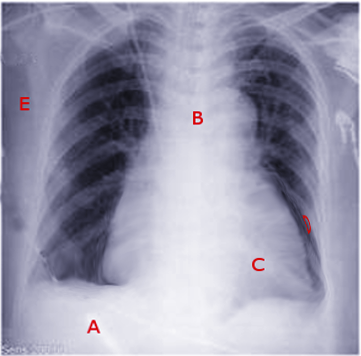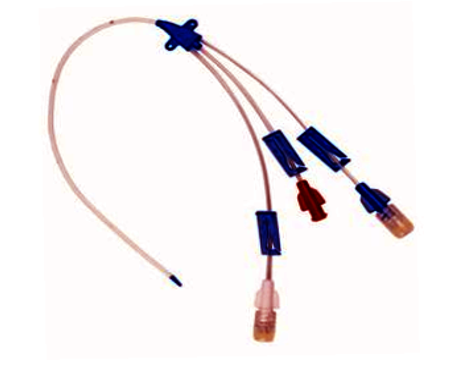[1]
Mitsuda S,Tokumine J,Matsuda R,Yorozu T,Asao T, PICC insertion in the sitting position for a patient with congestive heart failure: A case report. Medicine. 2019 Feb;
[PubMed PMID: 30732193]
Level 3 (low-level) evidence
[2]
SELDINGER SI, Catheter replacement of the needle in percutaneous arteriography; a new technique. Acta radiologica. 1953 May
[PubMed PMID: 13057644]
[3]
Ruesch S,Walder B,Tramèr MR, Complications of central venous catheters: internal jugular versus subclavian access--a systematic review. Critical care medicine. 2002 Feb
[PubMed PMID: 11889329]
Level 1 (high-level) evidence
[4]
McGee DC, Gould MK. Preventing complications of central venous catheterization. The New England journal of medicine. 2003 Mar 20:348(12):1123-33
[PubMed PMID: 12646670]
[5]
Turba UC,Uflacker R,Hannegan C,Selby JB, Anatomic relationship of the internal jugular vein and the common carotid artery applied to percutaneous transjugular procedures. Cardiovascular and interventional radiology. 2005 May-Jun;
[PubMed PMID: 15770389]
[6]
Denys BG,Uretsky BF, Anatomical variations of internal jugular vein location: impact on central venous access. Critical care medicine. 1991 Dec;
[PubMed PMID: 1959371]
[7]
McGee WT,Moriarty KP, Accurate placement of central venous catheters using a 16-cm catheter. Journal of intensive care medicine. 1996 Jan-Feb
[PubMed PMID: 10160067]
[8]
Tan BK,Hong SW,Huang MH,Lee ST, Anatomic basis of safe percutaneous subclavian venous catheterization. The Journal of trauma. 2000 Jan
[PubMed PMID: 10647570]
[9]
Mumtaz H,Williams V,Hauer-Jensen M,Rowe M,Henry-Tillman RS,Heaton K,Mancino AT,Muldoon RL,Klimberg VS,Broadwater JR,Westbrook KC,Lang NP, Central venous catheter placement in patients with disorders of hemostasis. American journal of surgery. 2000 Dec
[PubMed PMID: 11182407]
[10]
Ge X,Cavallazzi R,Li C,Pan SM,Wang YW,Wang FL, Central venous access sites for the prevention of venous thrombosis, stenosis and infection. The Cochrane database of systematic reviews. 2012 Mar 14
[PubMed PMID: 22419292]
Level 1 (high-level) evidence
[11]
Deshpande KS,Hatem C,Ulrich HL,Currie BP,Aldrich TK,Bryan-Brown CW,Kvetan V, The incidence of infectious complications of central venous catheters at the subclavian, internal jugular, and femoral sites in an intensive care unit population. Critical care medicine. 2005 Jan
[PubMed PMID: 15644643]
[12]
Parienti JJ,Thirion M,Mégarbane B,Souweine B,Ouchikhe A,Polito A,Forel JM,Marqué S,Misset B,Airapetian N,Daurel C,Mira JP,Ramakers M,du Cheyron D,Le Coutour X,Daubin C,Charbonneau P,Members of the Cathedia Study Group., Femoral vs jugular venous catheterization and risk of nosocomial events in adults requiring acute renal replacement therapy: a randomized controlled trial. JAMA. 2008 May 28;
[PubMed PMID: 18505951]
Level 1 (high-level) evidence
[13]
American Society of Anesthesiologists Task Force on Central Venous Access, Rupp SM, Apfelbaum JL, Blitt C, Caplan RA, Connis RT, Domino KB, Fleisher LA, Grant S, Mark JB, Morray JP, Nickinovich DG, Tung A. Practice guidelines for central venous access: a report by the American Society of Anesthesiologists Task Force on Central Venous Access. Anesthesiology. 2012 Mar:116(3):539-73. doi: 10.1097/ALN.0b013e31823c9569. Epub
[PubMed PMID: 22307320]
Level 1 (high-level) evidence
[14]
Bodenham Chair A,Babu S,Bennett J,Binks R,Fee P,Fox B,Johnston AJ,Klein AA,Langton JA,Mclure H,Tighe SQ, Association of Anaesthetists of Great Britain and Ireland: Safe vascular access 2016. Anaesthesia. 2016 May
[PubMed PMID: 26888253]
[15]
van de Weerdt EK, Biemond BJ, Baake B, Vermin B, Binnekade JM, van Lienden KP, Vlaar APJ. Central venous catheter placement in coagulopathic patients: risk factors and incidence of bleeding complications. Transfusion. 2017 Oct:57(10):2512-2525. doi: 10.1111/trf.14248. Epub 2017 Aug 30
[PubMed PMID: 28856685]
[16]
Tercan F,Ozkan U,Oguzkurt L, US-guided placement of central vein catheters in patients with disorders of hemostasis. European journal of radiology. 2008 Feb
[PubMed PMID: 17482407]
[17]
Ely EW,Hite RD,Baker AM,Johnson MM,Bowton DL,Haponik EF, Venous air embolism from central venous catheterization: a need for increased physician awareness. Critical care medicine. 1999 Oct;
[PubMed PMID: 10548191]
[18]
Gornik HL,Gerhard-Herman MD,Misra S,Mohler ER 3rd,Zierler RE,Peripheral Vascular Ultrasound and Physiological Testing Part II: Testing for Venous Disease and Evaluation of Hemodialysis Access Technical Panel.,Appropriate Use Criteria Task Force., ACCF/ACR/AIUM/ASE/IAC/SCAI/SCVS/SIR/SVM/SVS/SVU 2013 appropriate use criteria for peripheral vascular ultrasound and physiological testing part II: testing for venous disease and evaluation of hemodialysis access: a report of the american college of cardiology foundation appropriate use criteria task force. Journal of the American College of Cardiology. 2013 Aug 13;
[PubMed PMID: 23876422]
[19]
Mimoz O, Lucet JC, Kerforne T, Pascal J, Souweine B, Goudet V, Mercat A, Bouadma L, Lasocki S, Alfandari S, Friggeri A, Wallet F, Allou N, Ruckly S, Balayn D, Lepape A, Timsit JF, CLEAN trial investigators. Skin antisepsis with chlorhexidine-alcohol versus povidone iodine-alcohol, with and without skin scrubbing, for prevention of intravascular-catheter-related infection (CLEAN): an open-label, multicentre, randomised, controlled, two-by-two factorial trial. Lancet (London, England). 2015 Nov 21:386(10008):2069-2077. doi: 10.1016/S0140-6736(15)00244-5. Epub 2015 Sep 18
[PubMed PMID: 26388532]
Level 1 (high-level) evidence
[20]
Johnson E,Babb J,Sridhar D, Routine Antibiotic Prophylaxis for Totally Implantable Venous Access Device Placement: Meta-Analysis of 2,154 Patients. Journal of vascular and interventional radiology : JVIR. 2016 Mar
[PubMed PMID: 26776446]
Level 1 (high-level) evidence
[21]
Tang HJ,Lin HL,Lin YH,Leung PO,Chuang YC,Lai CC, The impact of central line insertion bundle on central line-associated bloodstream infection. BMC infectious diseases. 2014 Jul 1
[PubMed PMID: 24985729]
[22]
Ho AM,Ricci CJ,Ng CS,Critchley LA,Ho AK,Karmakar MK,Cheung CW,Ng SK, The medial-transverse approach for internal jugular vein cannulation: an example of lateral thinking. The Journal of emergency medicine. 2012 Feb
[PubMed PMID: 22056111]
[23]
Andrews RT,Bova DA,Venbrux AC, How much guidewire is too much? Direct measurement of the distance from subclavian and internal jugular vein access sites to the superior vena cava-atrial junction during central venous catheter placement. Critical care medicine. 2000 Jan;
[PubMed PMID: 10667513]
[24]
Robinson JF,Robinson WA,Cohn A,Garg K,Armstrong JD 2nd, Perforation of the great vessels during central venous line placement. Archives of internal medicine. 1995 Jun 12
[PubMed PMID: 7763129]
[25]
Polderman KH,Girbes AJ, Central venous catheter use. Part 1: mechanical complications. Intensive care medicine. 2002 Jan;
[PubMed PMID: 11818994]
[26]
Abood GJ,Davis KA,Esposito TJ,Luchette FA,Gamelli RL, Comparison of routine chest radiograph versus clinician judgment to determine adequate central line placement in critically ill patients. The Journal of trauma. 2007 Jul
[PubMed PMID: 17622868]
[27]
Eisen LA,Narasimhan M,Berger JS,Mayo PH,Rosen MJ,Schneider RF, Mechanical complications of central venous catheters. Journal of intensive care medicine. 2006 Jan-Feb
[PubMed PMID: 16698743]
[28]
Stone MB,Nagdev A,Murphy MC,Sisson CA, Ultrasound detection of guidewire position during central venous catheterization. The American journal of emergency medicine. 2010 Jan;
[PubMed PMID: 20006207]
[29]
Vinson DR, Ballard DW, Hance LG, Stevenson MD, Clague VA, Rauchwerger AS, Reed ME, Mark DG, Kaiser Permanente CREST Network Investigators. Pneumothorax is a rare complication of thoracic central venous catheterization in community EDs. The American journal of emergency medicine. 2015 Jan:33(1):60-6. doi: 10.1016/j.ajem.2014.10.020. Epub 2014 Oct 18
[PubMed PMID: 25455050]
[30]
Beathard GA,Litchfield T,Physician Operators Forum of RMS Lifeline, Inc., Effectiveness and safety of dialysis vascular access procedures performed by interventional nephrologists. Kidney international. 2004 Oct;
[PubMed PMID: 15458459]
[31]
Guilbert MC,Elkouri S,Bracco D,Corriveau MM,Beaudoin N,Dubois MJ,Bruneau L,Blair JF, Arterial trauma during central venous catheter insertion: Case series, review and proposed algorithm. Journal of vascular surgery. 2008 Oct
[PubMed PMID: 18703308]
Level 2 (mid-level) evidence
[32]
Nicholson T,Ettles D,Robinson G, Managing inadvertent arterial catheterization during central venous access procedures. Cardiovascular and interventional radiology. 2004 Jan-Feb
[PubMed PMID: 15109223]
[33]
Pittiruti M,Lamperti M, Late cardiac tamponade in adults secondary to tip position in the right atrium: an urban legend? A systematic review of the literature. Journal of cardiothoracic and vascular anesthesia. 2015 Apr;
[PubMed PMID: 25304887]
Level 1 (high-level) evidence
[34]
Lok CE,Mokrzycki MH, Prevention and management of catheter-related infection in hemodialysis patients. Kidney international. 2011 Mar
[PubMed PMID: 21178979]
[35]
Lee T,Barker J,Allon M, Tunneled catheters in hemodialysis patients: reasons and subsequent outcomes. American journal of kidney diseases : the official journal of the National Kidney Foundation. 2005 Sep
[PubMed PMID: 16129212]
[36]
Agarwal AK, Central vein stenosis: current concepts. Advances in chronic kidney disease. 2009 Sep
[PubMed PMID: 19695504]
Level 3 (low-level) evidence
[37]
Geerts W. Central venous catheter-related thrombosis. Hematology. American Society of Hematology. Education Program. 2014 Dec 5:2014(1):306-11. doi: 10.1182/asheducation-2014.1.306. Epub 2014 Nov 18
[PubMed PMID: 25696870]
[38]
Levit O,Shabanova V,Bizzarro M, Impact of a dedicated nursing team on central line-related complications in neonatal intensive care unit. The journal of maternal-fetal
[PubMed PMID: 30612486]
[39]
Chick JF,Reddy SN,Yam BL,Kobrin S,Trerotola SO, Institution of a Hospital-Based Central Venous Access Policy for Peripheral Vein Preservation in Patients with Chronic Kidney Disease: A 12-Year Experience. Journal of vascular and interventional radiology : JVIR. 2017 Mar;
[PubMed PMID: 28111198]


